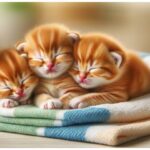When it comes to choosing the right food for your cat, navigating the maze of cat food labels can be daunting. With so many brands and varieties on the market, understanding what those labels mean is crucial for making informed decisions about your pet’s nutrition. This guide will help you decode cat food labels, focusing on the four AAFCO rules, the importance of macronutrients, indicators of high-quality food, and red flags to watch out for.
The Four AAFCO Rules of Cat Food Labels
The Association of American Feed Control Officials (AAFCO) sets standards for pet food labeling to ensure consistency and accuracy. Here are the four key AAFCO rules you should know:
- Product Name Rule: The name of the cat food provides important clues about the ingredients. For instance:
- “Chicken Cat Food” must contain at least 95% chicken.
- “Chicken Dinner” or “Chicken Formula” means the food contains at least 25% chicken.
- “With Chicken” indicates the food has at least 3% chicken.
- “Chicken Flavor” means there is enough chicken to impart flavor but doesn’t specify a minimum amount.
- Guaranteed Analysis: This section lists the minimum or maximum levels of nutrients in the food, such as protein, fat, fiber, and moisture. While these values are helpful, they don’t tell the whole story about the quality of the ingredients.
- Ingredient List: Ingredients are listed in descending order by weight. Look for high-quality proteins as the first ingredient and avoid foods with fillers or by-products.
- Nutritional Adequacy Statement: This statement confirms if the food meets AAFCO nutrient profiles for the intended life stage of the cat (e.g., growth, maintenance, all life stages). It ensures that the food provides complete and balanced nutrition.
The Importance of Macronutrients in Cat Food
Cats are obligate carnivores, meaning their diet should be rich in animal-based proteins and fats. Here’s what to look for in the guaranteed analysis:
- Protein: Cats require a high-protein diet to support muscle development, maintenance, and overall health. Look for foods with a protein content of at least 30% on a dry matter basis. High-quality protein sources include chicken, turkey, fish, and beef.
- Fat: Fats are essential for energy, coat health, and absorption of fat-soluble vitamins. A good cat food should contain 15-20% fat. Sources like chicken fat, fish oil, and flaxseed oil are beneficial.
- Fiber: Fiber aids in digestion and prevents hairballs. While cats don’t need much fiber, a small amount (1-5%) from sources like beet pulp or pumpkin can be beneficial.
- Moisture: Cats are not naturally big drinkers, so moisture content is important, especially in wet food. Wet cat food should have around 75-78% moisture, while dry food typically has about 10%.
Indicators of High-Quality Cat Food
To ensure you’re feeding your cat the best, look for these indicators of high-quality cat food:
- Named Protein Sources: The first ingredient should be a named protein source (e.g., chicken, salmon) rather than vague terms like “meat” or “poultry.”
- Whole Ingredients: Foods that use whole ingredients like vegetables, fruits, and grains (if included) are generally of higher quality.
- Absence of Fillers and By-Products: Avoid foods with fillers like corn, soy, and wheat, as well as animal by-products, which can be of lower nutritional value.
- Natural Preservatives: Look for natural preservatives like vitamin E (mixed tocopherols) and vitamin C instead of artificial ones like BHA, BHT, or ethoxyquin.
Red Flags to Watch Out For On Cat Food Labels
While scanning cat food labels, be wary of these red flag items:
- Artificial Colors and Flavors: These additives are unnecessary and can be harmful. Look for foods without artificial colors and flavors.
- Excessive Carbohydrates: Cats don’t need a lot of carbs. Avoid foods with high levels of grains, potatoes, or other starches.
- Multiple Low-Quality Ingredients: If a food lists several low-quality ingredients like “corn gluten meal” or “meat by-products,” it’s best to avoid it.
- Ambiguous Terms: Terms like “meat meal” or “animal fat” can indicate poor-quality ingredients. Opt for products that specify the type of meat or fat used.
Conclusion
Reading cat food labels doesn’t have to be overwhelming. By understanding the AAFCO rules, recognizing the importance of macronutrients, identifying high-quality ingredients, and spotting red flags, you can make the best choices for your feline friend. Providing your cat with high-quality nutrition is one of the most important things you can do to ensure a happy, healthy life.
Remember, when in doubt, consult with your veterinarian to choose the best food for your cat’s specific needs. Happy feeding!






